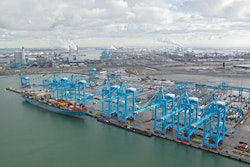
Few can argue that the global food supply chain is rife with complexities. It is an image of a supply network with myriad actors operating with disparate systems all with the goal of delivering food to the customer. Within such a complex ecosystem, numerous questions abound. Regardless of whether it’s a question of origin, regulatory compliance or the like, most are centered around the same issue—transparency. While elusive for many supply partners in the food chain, transparency now has an ally in blockchain technology.
Blockchain Demystified
In the food world, blockchain could not have arrived at a better time with several high-profile cases of food contamination and fraud making headlines. While still undergoing pilot testing within companies and among their supply chain partners, blockchain is poised to transform the food industry. But what is blockchain? Within a supply chain context, it’s an encrypted digital ledger shared by multiple supply chain partners that provides permanent transparency and validation of transactions.
C. John Langley Jr., Ph.D., clinical professor of supply chain management at Penn State University and coauthor of the 2018 Third-Party Logistics Study, says the increased desire for visibility within the supply chain is driving increased interest in blockchain technology, which breaks each movement down into a block and documents transactions every time a shipment changes hands. Linking the blocks together creates a record for parties involved in the process and provides specific details associated with each movement, which all parties can access.
“This creates a permanent, digital history as products move throughout the supply chain from the original source through the final leg of the journey. The goal is to create one version of the truth, link information, create transparency surrounding all parties involved in the supply chain, and identify how they participated in the flow of a good or service,” says Langley. “As a bonus, the digital history is not owned or controlled by any one trading partner, so it can be available for all verified partners to use.
No one party can modify, delete or append any record without the consensus from others on the network, adds Langley. “Data generated through blockchain technology could provide more opportunity to analyze information, which is becoming more important in today’s data-driven supply chain. Blockchain also has the potential to create demand chains because it closely tracks and transmits data in real time related to consumption.”
Lance Koonce, partner for Davis Wright Tremaine LLP and head of the firm’s cross-practice blockchain initiative, says blockchain can address those issues around complexity and opaqueness by providing verifiable, granular data.
“There’s excitement around the ability for blockchains to enable improved, more detailed tracking of food products,” he says. “There’s also the collaboration aspect where sharing of critical information can occur among parties that traditionally operate in separate silos. Thus, when an incident of food contamination occurs, for example, rather than taking days or weeks to track the source, can now take minutes through improved transparency.”
The reality is that blockchain mirrors a very decentralized and fragmented world, says Raja Ramachandran, CEO for ripe.io, a company developing its own blockchain for the food system. Blockchain allows that fragmented world to bind its data, its workflows and its activities into something that people can recognize as a record of truth.
A company that manages the ripening process for produce is connected to cold storage, transporters and ultimately buyers with the goal of providing optimally fresh produce at the time it’s needed. However, how is that process validated? How is it true? Ramachandran says those questions can be answered on the blockchain as a single activity of record. Blockchain provides the ability to segregate the data capture and control the data sharing to validate that things are occurring as intended from the fulfillment process through transportation tracking to final purchase.
“The blockchain is really this fabric and code automation that binds all that together, and more importantly asks each of the participants to effectively provide a consensus that the claim or assertion is true,” he says. “If someone certifies something, you typically rely on a third party. Now, the entire supply chain can self-certify because it’s looking to agree with each other.”
Improving Food Supply Chains Through Blockchain
With the technology’s focus on transparency and verification, blockchain is an ideal solution for the global food supply chain. Still in its infancy, blockchain can have a significant impact on food safety, fraudulent food, and sustainability and corporate social responsibility.
Food safety and fraud transparency. The Centers for Disease Control and Prevention estimates annually 48 million people become sick from foodborne illness, leaving 128,000 hospitalized and 3,000 dead.
Many consumers are unaware of where their food comes from and how it’s produced—blockchain provides that visibility. Koonce says supply chain opacity runs counter to the emphasis on transparency that is emerging in the food marketplace. Companies want the ability to tell stories about honest products and provide accurate labeling.
“You can’t control what you can’t see,” says Koonce. “When you have an opaque supply network, it leaves the window open for such things as fraud and food safety breaches. Much of it stems from a lack of accountability, resulting in the inability to mitigate those risks and respond quickly if they arise.”
Ramachandran agrees and adds that the lack of trust and seeking of information about what we eat and feed our families is driving the need for transparency, accounting for the single-largest issue affecting global food supply chains.
“This is not central to only the United States but globally as well. And from a business perspective, transparency goes beyond just risk management for farmers and large companies, but also brand integrity. People are asking Unilever, Campbell’s, Pepsi and others, including farmers, about their food, how it’s grown, processed, transported and the safety standards involved.”
Sustainability and corporate social responsibility (CSR). Now, more than ever, consumers are holding food companies accountable for their environmental and social impacts on the world. According to Statista’s 2015 Sustainable Food Industry—Statistics and Facts, “Some 42 percent of North American consumers said they are willing to pay more for sustainable products. In addition, more than half of American consumers said they depend on the company to disclose information about the health and sustainability of their products, and three quarters expressed a desire for more companies to report this kind of information.”
With many companies releasing annual sustainability or CSR reports, blockchain provides an additional layer of supply chain accountability and transparency. This includes agricultural data retrieved from sensors that measure soil quality as well as critical information from food processing equipment.
Ramachandran says there are two dynamics occurring in the world. First, is meeting food demand for vastly growing populations on the planet. According to the High-Level Expert Forum’s How to Feed the World 2050 report, the world population is expected to grow by over a third, or 2.3 billion people, between 2009 and 2050. To feed such a growing population requires low cost and wide accessibility, but also reengineering of food production processes to avoid such things as food spoilage that accounts for nearly 25 percent of water waste.
Second, is recognizing the movement toward sustainable soil management and growth, with emphasis on locally grown produce, says Ramachandran. Major food brands are feeling the effects of this trend as are grocery stores and chemical companies that provide incentives for low-carbon farming. “There’s a great deal of science and effort around yield as well as understanding how to maximize what comes out of a field and the associated proteins,” he says.
Ripe.io has conducted small pilots that showcased the end-to-end chain from seed to mouth of fresh produce, capturing data related to field growth conditions, temperature data within distribution trucks and information extracted from sensors on companies’ food processing machinery, adds Ramachandran.
“We then build a model based on the data to incorporate smart contracts around the process. Regardless of your data methodology (for example, barcodes, RFID, QR codes and the like), a self-executing code (smart contract) uses the data on the blockchain to issue a certification of verifiability and traceability,” he explains.
Impact of Blockchain for Global Food Supplier
Where can blockchain impact CSR goals and initiatives on a global level? As the world’s largest tuna exporter, Thai Union Group in Bangkok operates among an array of supply chain complexities. Most notably, the fishing industry’s fight to eliminate illegal fishing and human rights abuses. The company envisions the use of blockchain throughout its global operations and supply chain.
Darian McBain, Ph.D., global director for sustainable development for Thai Union Group, says Thai Union is committed to demonstrating complete supply chain transparency and traceability. The company implemented a traceability system enabling it to monitor and manage the exclusion of illegal, unreported and unregulated fish from its supply chain. However, the system is partly paper-based.
“Paper-based systems are not perfect. Thus, we’re exploring and implementing digital traceability solutions to help address those inefficiencies and errors. Digital traceability in supply chains is a big step toward ensuring sustainability,” says McBain. “We were the first company globally to introduce a can tracker on canned tuna products, allowing consumers to trace their product back to species, vessel, ocean and fishing trip. We are also looking at using digital traceability to improve connectivity at sea for workers.”
McBain foresees blockchain as an opportunity to secure supply chains through the use of cryptographic signatures or a shared ledger, and assurance for each step of the data chain, from sourcing to production to the consumer. The evolving use of blockchain technology for digital payments across borders and for digital identity is also appealing for the work the company does to support safe and legal migration of workers.
There are several traceability programs Thai Food is implementing where blockchain can be most valuable in tracking supply chain transparency and regulatory compliance. For example, McBain says blockchain technology teamed with its tuna can tracker tool could provide verification for each block of the chain on the flow of goods. “Blockchain can also help ensure we’re meeting regulatory and customer requirements, as well as providing a consumer interface that is both informative and transparent about the global food supply chain.”
Thai Union launched a digital traceability pilot program where maritime telecommunications provider Inmarsat installed its Fleet One terminals on fishing vessels in Thailand. “The program tests scalable platforms for electronic catch data and traceability systems that utilize mobile applications and satellite connectivity, making it possible to demonstrate true electronic end-to-end traceability and supply chain management,” says McBain.
In another pilot program, crew members, captains and fleet owners were trained on “Fish Talk” chat applications developed by Xsense—an industry first for Thai fisheries, says McBain. “More importantly for human rights, the pilot brings with it the ability for workers on the vessels to use ‘Fish Talk’ to communicate with loved ones back on shore. There is so much potential around blockchain technology, and we are exploring how to use it throughout our supply chain to complement our pilot programs.”
Value of Blockchain Is Evolving
With the possibility to improve supply chain transparency and traceability and condense complex supply chain transactions into verifiable, trusted data blocks, there’s promising potential for blockchain. In its May 2017 benchmark survey, Blockchain in Supply Chain: Edging Toward Higher Visibility, Chain Business Insights reveals that supply chain professionals view improved supply chain visibility/transparency (45.9 percent); reduced transaction costs (24.3 percent); and enhanced trust between supply chain partners (13.5 percent) as the primary advantages of blockchain.
However, Koonce says blockchain is not a magic solution for everything. It’s simply a different way of sharing information, but at a rapid speed with greater detailed data among different parties. There needs to be caution in assuming blockchains are going to replace existing software.
“Blockchains don’t scale as easily as other software solutions. They’ll be used where it’s most helpful—in processes where many parties are involved, high levels of complexity exist and information requires transparency,” says Koonce. “If you can provide better, quicker data, then that on its own provides greater efficiencies because parties can improve their decision-making.”
An area where blockchain can enhance efficiencies and lead to potential innovations is billing and invoicing. Koonce says an exciting segment, although still in the development phase, is smart contracts where parties operating on the same blockchain enter into contracts and execute them through an automated process. This can lead to faster payments times between supply chain partners.
“We could see the development of entirely new types of payment systems as blockchains are implemented,” says Koonce. “This, in turn, may lead to fewer middlemen in the supply chain who currently certify transactions among parties. Blockchain automates that issue of trust, reducing or eliminating parties that provide some of those roles.”
Ramachandran agrees with Koonce that blockchain has the ability to transform industries and processes over time, but it doesn’t happen overnight. People need to get used to the notion of trust and everyone has a version of it.
“What blockchain does is creates a brighter light on the entire activities of an industry. There will be time to adjust and get people comfortable with that,” says Ramachandran. Once absorbed, it becomes a powerful tool.
He adds that there are going to be several blockchains—consortium chains, application-specific chains like traceability, IoT-driven chains, financial chains, insurance chains and the like. What should be avoided is forcing players in an industry to select one of many services. Rather, promote assurances that there’s inner operability amongst the various blockchains.
“If multiple blockchain providers have worked out those business models, then it should be seamless to the user,” says Ramachandran. “The blockchains must align with business models so that the individual user and individual companies can subscribe to one service with access to many.”
Blockchain provides the ability to view supply chains from a 30,000-foot perspective and say ‘How can we make them better?’ “It’s fair to say that if blockchains can help the global food supply chain increase accountability and transparency, make transactions more efficient and reduce complexities, those are enormous steps,” says Koonce.




















